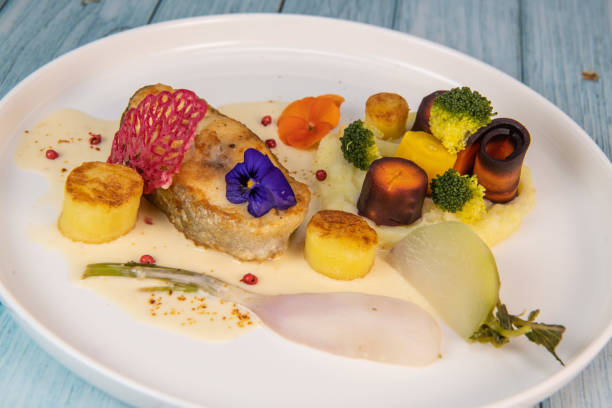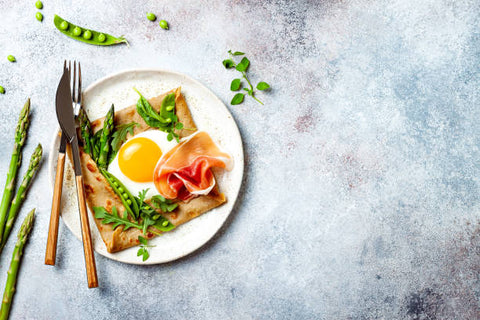In French cuisine, the presentation of a dish is considered an art form. The way food is plated can elevate a meal from ordinary to extraordinary, captivating both the eyes and the taste buds. In this article, we will explore the art of French plating and provide you with tips and techniques to create beautiful and appetizing dish presentations.
- Balance and Composition:
One of the fundamental principles of French plating is balance and composition. A well-plated dish should have a harmonious arrangement of elements, combining colors, textures, and shapes to create a visually appealing composition. Consider the placement of each component and aim for symmetry or asymmetry that is visually pleasing and balanced.
- Color and Contrast:
Color plays a crucial role in French plating, as vibrant and contrasting colors create visual interest. Incorporate a variety of colorful ingredients, such as fresh herbs, vibrant vegetables, or edible flowers, to add pops of color to your dish. Consider contrasting hues on the plate to make each ingredient stand out and create a visually striking presentation.
- Layering and Height:
Creating layers and height in your plating adds dimension and elegance to a dish. Use tools like ring molds or ramekins to stack and layer ingredients vertically. For example, you can layer mashed potatoes, sautéed vegetables, and a perfectly cooked protein to create a visually appealing tower. Additionally, garnish with vertical elements like sprigs of herbs or thin slices of vegetables to add height and visual interest.
- Negative Space:
Negative space refers to the intentional empty space on a plate that provides visual breathing room and highlights the main elements of the dish. Use negative space strategically to allow each component to shine. Avoid overcrowding the plate and leave some areas intentionally empty to create balance and draw attention to the focal point of the dish.
- Sauces and Drizzles:
Sauces and drizzles are not only flavor enhancers but also artistic elements in French plating. Use a squeeze bottle or a spoon to carefully drizzle sauces around the plate or create decorative patterns. Consider contrasting colors and shapes when adding sauce to create visual intrigue and complement the other components of the dish.
- Garnishes and Edible Accents:
Garnishes and edible accents add the finishing touch to a beautifully plated dish. Fresh herbs, microgreens, edible flowers, or delicate slices of citrus fruit can elevate the visual appeal of your plate. Think about textures and shapes when selecting garnishes, as they should complement and enhance the overall presentation.
- Proper Plate Selection:
The choice of plate is an essential aspect of French plating. Select plates that have a wide rim or a decorative edge to frame the dish. Consider the color of the plate as well, as it can either enhance or detract from the presentation of the food. White plates are commonly used as they provide a clean canvas for the colorful ingredients to stand out.
- Precision and Attention to Detail:
Lastly, precision and attention to detail are key in French plating. Take your time to carefully arrange each element, ensuring that they are placed with intention and precision. Use tools like tweezers or small spatulas to delicately position ingredients and make any necessary adjustments.
- Texture and Temperature Contrast:
In addition to visual elements, French plating also considers texture and temperature contrast. Incorporate a variety of textures in your dish, such as crispy, creamy, crunchy, or velvety, to add interest and dimension. For example, pair a seared steak with a smooth purée, or top a creamy risotto with a crispy garnish. Additionally, consider temperature contrast by combining hot and cold elements to create a dynamic sensory experience.
- Plating with Purpose:
Every element on the plate should serve a purpose and contribute to the overall dish. Avoid unnecessary clutter and focus on highlighting the key flavors and ingredients. Consider the balance between the main component, the supporting elements, and the garnishes, ensuring that each one adds value to the plate and enhances the overall dining experience.
- Seasonal and Local Ingredients:
Embrace the philosophy of using seasonal and local ingredients in your French plating. Not only do these ingredients offer the freshest flavors, but they also provide a natural color palette that reflects the time of year. Incorporating seasonal produce and locally sourced ingredients adds an element of authenticity and showcases the flavors of the region.
- Inspiration from Nature and Art:
Take inspiration from nature and art when designing your plate. Consider the organic shapes, patterns, and colors found in nature and translate them onto your plate. Think about the way artists use brushstrokes or the flow of a landscape painting and mimic those concepts through the arrangement of your ingredients. This approach adds a touch of creativity and artistic expression to your plating.
- Practice and Refinement:
Like any skill, the art of French plating requires practice and refinement. Experiment with different techniques, arrangements, and combinations of ingredients. Take the time to study and appreciate the plating styles of renowned French chefs for inspiration. Keep a record of your successful plating designs and learn from any mistakes or challenges you encounter along the way.
Remember, the goal of French plating is not just to create a visually stunning dish but also to enhance the overall dining experience. The presentation should complement the flavors and textures of the food, creating anticipation and excitement before the first bite. With time, patience, and a willingness to explore your creativity, you can master the art of French plating and elevate your culinary creations to new heights of beauty and sophistication.
The art of French plating is about more than just arranging food on a plate—it is a thoughtful and creative process that aims to engage all the senses. By incorporating principles of balance, composition, color, and contrast, as well as employing techniques like layering, creating height, utilizing negative space, and adding sauces and garnishes, you can transform your dishes into visually stunning culinary creations. Remember to let your creativity guide you, and don't be afraid to experiment and take risks. With practice and a keen eye for detail, you can master the art of French plating and impress both yourself and your guests with beautifully presented and appetizing meals.




